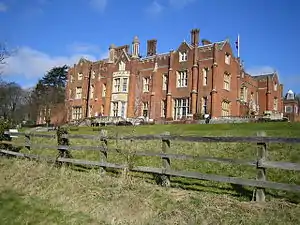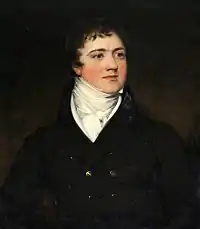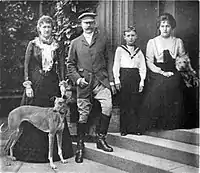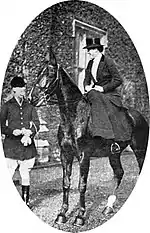Latimer House
Latimer House is a large country house at Latimer, Buckinghamshire. It is now branded as De Vere Latimer Estate[1] and functions as a countryside hotel used for country house weddings and conferences. Latimer Place has a small church, St Mary Magdalene, which was built by Lord Chesham, in the grounds.

The Cavendish family

Latimer House, a mansion on the hill on the edge of the village, was once a home of members of the Cavendish family who became the barons Chesham. The 3rd Baron Chesham was a commander in the Boer War.[2] The original Elizabethan house, where Charles I was imprisoned in 1647 and Charles II took refuge before fleeing abroad, was gutted by fire in the early 1830s and the present red brick Tudor style mansion, which was designed by Edward Blore, was completed in 1838.[3]
The House was built by Charles Compton Cavendish, 1st Baron Chesham (1793-1863) in 1838. He was the son of Lord George Augustus Henry Cavendish and Lady Elizabeth Compton who was the daughter of the 7th Earl of Northampton. In 1814 he married Lady Catherine Susan Gordon, daughter of George Gordon, 9th Marquess of Huntly.[4] The couple had three children, two daughters and one son. In 1818 he became a Member of Parliament and remained in this role for most of his life.[5]
His father had inherited the Latimer Estate some time before and there had been an old manor house on the property. On his father’s death in 1834 the property had passed to Charles with the manor but in 1838 there was a fire which caused severe damage to the house. Charles commissioned the famous architect Edward Blore to build the new house which was completed in 1838 and still stands today. A newspaper of that time made the following comment about the property. It stated:
- "Mr Blore has fully sustained his character as the most skilful reviver of the domestic architecture of “Merrie Old England” in his admiral restoration of the quaint and picturesque Latimers."[6]
Charles died in 1863 and his son William George Cavendish 2nd Baron Chesham (1815-1882) inherited Latimer House. He was educated at Eton College. He gained the rank of Officer in 1833 in the 10th Light Dragoons.[7]
In 1847 he was elected Member of Parliament for Peterborough, a seat he held until 1852, and later represented Buckinghamshire from 1857 to 1863. He then succeeded his father in the Barony and took his seat in the House of Lords.[8]

In 1849 Wjilliam married Henrietta Frances Lascelles, daughter of William Saunders Sebright Lascelles and his wife Lady Caroline Georgiana Howard, daughter of George Howard, 6th Earl of Carlisle. The couple had five children the eldest of whom was Major General Charles Compton William Cavendish (1850-1907) who became the 3rd Baron Chesham when his father died in 1882.[7]

Major General Charles Compton William Cavendish was born in 1850 in London. He married Lady Beatrice Constance Grosvenor, daughter of Hugh Lupus Grosvenor, 1st Duke of Westminster and Lady Constance Gertrude Sutherland-Leveson-Gower, on 13 November 1877.[9] He had a very distinguished military career and fought in the Boer War where he received very favourable commendations. He had four children, one of whom was Lilah Cavendish. In 1903 Lilah was married at Latimer and the wedding was such a lavish affair that it was mentioned in numerous newspapers including some in Australia. The Australian paper gave the following description of the event:
- "The church being within the grounds of Latimer, the family seat of the Cavendish family, the bridal party walked to It, the bride being accompanied by, her father, who gave her away. She wore a gown of white chiffon over satin, tastefully trimmed with Brussels lace and orange blossom, and a white satin train veiled with lace and embroidered with silver. Her chief jewel was a diamond and pearl cross brooch given by the bridegroom, and she carried a lovely Goodyear bouquet of lilies of the valley and white roses.[10]
The magazine called “The Gentlewoman” carried a large picture of the bridal party returning from the Church after the wedding to Latimer House.[11]
The 3rd Baron Chesham died in a hunting accident in 1907 when his horse stumbled while jumping a fence. His son John Compton Cavendish who was only 13 years old at the time became the 4th Baron Chesham.[7]
John Compton Cavendish, 4th Baron Chesham (1894-1952), was educated at Eton College and later gained the rank of Captain in the 10th Hussars. He fought in both the first and second World Wars and in the First World War was awarded the Military Cross.[12]
Second World War
During the Second World War, the house was the headquarters of IV Corps from August 1940.[13] It was also one of three stately homes where captured German U-boat submarine crews and Luftwaffe pilots were initially held before being transferred to conventional prisoner of war camps.[14]
National Defence College
John Compton Cavendish, 4th Baron Chesham died in 1952 and a year later the house became the home of the British military's National Defence College.[15] On 12 February 1974, a bomb containing about 20 lbs of explosive, was placed close to one of the main buildings at the National Defence College by the Irish Republican Army. At 9.10 am the bomb exploded injuring 10 people but with no fatalities. Damage estimated at over £6,000 was caused.[16]
Present day
Latimer Place is currently run as an independent hotel with conference facilities and branded the De Vere Latimer Estate.[17] It was the subject of a TV documentary in the ITV series Britain's Secret Homes.[18]
References
- "De Vere Latimer Estate".
- "Charles Compton William Cavendish, 3rd Baron Chesham, KCB PC". Cracrofts Peerage. Retrieved 8 July 2014.
- Historic England. "Latimer Park (1000370)". National Heritage List for England. Retrieved 8 July 2014.
- The Peerage website. Online reference
- History of Parliament website. Online reference
- The Bucks Herald - Saturday 30 March 1839, p. 3.
- "Chesham, Baron (UK, 1858)". Cracroft's Peerage. Retrieved 2 September 2017.
- The Peerage website. Online reference
- The Peerage website Online reference
- "Marriage". The Australian Star. 5 September 1903. p. 9.
- The Gentlewoman and Modern Life, vol. XXVII, no. 680, 1903, p. 71.
- The Peerage website Online reference
- Newbold, p. 367
- "The Nazi prisoners bugged by Germans". BBC News. Retrieved 18 January 2013.
- "Latimer House (National Defence College), Latimer". British Listed Buildings. Retrieved 8 July 2014.
- "Regina versus Ward" (PDF). Court of Appeal. Retrieved 12 April 2015.
- "Latimer Place wins Britain's Secret Homes". Bucks Free Press. 9 September 2013. Retrieved 8 July 2014.
- "Britain's Secret Homes Episode 5". presscentre. Retrieved 12 April 2015.
Sources
| Wikimedia Commons has media related to Latimer House, Buckinghamshire. |
- Newbold, David John. "British planning and preparations to resist invasion on land, September 1939 - September 1940". kclpure.kcl.ac.uk. King's College, University of London. Retrieved 1 August 2015.